by Amineddoleh & Associates LLC | Aug 13, 2024 |

Woman Ironing, Pablo Picasso (1904).
Earlier this summer, Leila A. Amineddoleh was quoted in an article in ARTnews about a recently dismissed case in the Southern District of New York. The dispute involved claims that the painting in question, a Picasso work (Woman Ironing) valued at $150 million, was sold under duress during the Nazi Era.
Unfortunately, courts have not had clear guidance on what constitutes a “duress sale” because judges have been punting that question for years. Thus, Nazi-era cases are often decided on technical grounds, like jurisdictional determinations or time limitations. As Leila predicted last January, Bennigson v. The Solomon R. Guggenheim Found., 1013 N.Y. Slip Op. 24164, one of the most recent Nazi-looted art litigations, was dismissed on technical grounds, namely laches. In Bennigson, the Southern District of New York found that the heirs of Karl Adler (a German Jewish man) had waited too long to file a claim because the family had known about the location of the Picasso painting for decades.
The court granted the Guggenheim Motion to Dismiss, primarily based upon the affirmative defense of laches. Judge Andrew Borrok found that laches is still a relevant defense, even after the passage of the Holocaust Expropriated Art Recovery Act (the HEAR Act). The Act was passed to prevent Nazi-looted art restitution claims from being barred on statute of limitations grounds. The court stated, “not only does laches continue to be an appropriate defense [even after the passage of the HEAR Act]…, it may also be resolved as a matter of law at the motion to dismiss stage where the original owner’s lack of diligence and prejudice to the party currently in possession are apparent.” The court cited a number of recent cases, stating, “The HEAR Act explicitly precludes application of “defense[s] at law relating to the passage of time” but does not interfere with the application of defenses at equity, such as laches (Pub L. No. 114-308, 130 Stat. 1524, § 5[a]; Zuckerman v Metro. Museum of Art, 928 F3d 186, 196 [2d Cir 2019]; Reif v Art Inst. of Chicago, 2023 WL 8167182, at *1 [SDNY Nov. 24, 2023], reconsideration denied sub nom. Timothy Reif, et al., Plaintiffs, v The Art Institute of Chicago, Defendant, 2024 WL 838431 [SDNY Feb. 28, 2024]). The court found that the heirs had demonstrated “over 40 years distinct lack of diligence in not raising any concerns.”
However, while the court dismissed the matter based on laches, the opinion ultimately does address duress as a secondary basis for dismissal and it provides guidance for future disputes. Here, Judge Borrok found that the Plaintiff’s Amended Complaint failed to allege any actionable duress under NY law. Amongst other considerations, the opinion pointed to a letter from the Guggenheim to Eric Adler (the eldest son of the seller, Karl Adler). The museum’s letter explained that it was researching the provenance of the painting as it was preparing a catalogue for a collection within the institution. In response, Eric Adler confirmed that the painting was purchased by his parents in 1916 and sold in 1939, but he did not allude to a duress sale or anything else concerning the disposition of the painting. There was no reference in his letter to demanding the restitution of the painting. This, among other reasons, led the court to find that the sale was not made under duress.
Still, the court acknowledges the horrors of WWII and extensively quotes language from the Amended Complaint that recounts the tragedies that occurred during that period. One particularly heartbreaking paragraph was:
“On September 15, 1935, with the enactment of the Nuremberg Laws (“The Laws for the Protection of German Blood and German Honor”), the Nazis consolidated and extended the existing exclusionary measures against Jews. The Nuremberg Laws deprived all German Jews, including Karl and Rosa, of the rights and privileges of German citizenship, ended any normal life or existence for them and relegated them to a marginalized existence, a pivotal step toward their mass extermination.”
While dismissal of Bennigson was primarily based on laches, the court also took the opportunity to examine the duress claims and it provide guidance for future litigations involving Nazi-era takings and war-era transactions.
by Amineddoleh & Associates LLC | Sep 9, 2022 |
A New York bill signed into law on August 10, 2022 will require museums to provide a notice to viewers if works of art on display have links to the Holocaust. This groundbreaking and restorative legislation accompanies two other Holocaust-related bills signed into law: one aimed at increasing Holocaust literacy through curricula in educational institutions, and the other designed to increase pressure on banks that assess fees related to Holocaust reparations. All three bills work in concert to combat rising reports of antisemitism through these targeted cultural, economic, and educational channels.
Provenance
While other states are considering enacting similar legislation to increase Holocaust literacy in schools, New York stands apart in dictating these trailblazing requirements for museums to publicly acknowledge the devastating conditions under which they may have acquired certain works. The origin of a work of art is known as its provenance, and its applicability extends beyond Holocaust-era stolen works (you can access our blog post on the fight to prove provenance for Mexican antiquities here). Provenance is important not only to establish a chain of title when purchasing a work, but also to determine its cultural, political, and financial value.
Proving provenance is no small task, particularly when items have been stolen. This task is rendered even more difficult when the theft occurred during or shortly after the chaos of war. In the case of works stolen during the Holocaust, both these hurdles were present, with the added complications of global economic upheaval, unimaginable human suffering, an overwhelming refugee crisis, and the genocide of the class of people from whom the works were primarily stolen. The process of proving provenance for works stolen during WWII typically involves the heirs of deceased Jewish family members bringing claims to museums in hopes of establishing legitimate ownership of works held by a museum through whatever documents were salvaged after the war. This can include references in letters and diaries, family photographs, and bills of sale. The museum then has its own systems to determine the legitimacy of such claims. If provenance is not proven after the museum’s internal investigation, the museum is then able to claim that it “legally” retains the artwork.
 Of course, this is devastating news to families seeking to reclaim an important piece of family heritage. If a museum denies heirs’ claims, they may proceed to file litigation. One high-profile example is Gustav Klimt’s portrait of Maria Altmann, titled Woman in Gold. Another is the ongoing Cassirer case, involving the Museo Thyssen-Bornemisza in Madrid. However, these cases often take years – if not decades – to resolve, leaving the artwork in legal limbo until a final decision or settlement is made.
Of course, this is devastating news to families seeking to reclaim an important piece of family heritage. If a museum denies heirs’ claims, they may proceed to file litigation. One high-profile example is Gustav Klimt’s portrait of Maria Altmann, titled Woman in Gold. Another is the ongoing Cassirer case, involving the Museo Thyssen-Bornemisza in Madrid. However, these cases often take years – if not decades – to resolve, leaving the artwork in legal limbo until a final decision or settlement is made.
It is important to keep in mind that Gov. Hochul’s new law does not specifically address the need to return works to individual families (restitution). However, it does bring to light the importance of acknowledging a work’s provenance as an important cultural indicator of the suffering of a class of people, even if it does not repair the harm done to individual families. Thus, the heirs or successors-in-interest of a dispossessed owner will need to rely on alternative avenues to recover their property.
Restitution
The effect of the public notice requirement speaks to justice outside the courts that can be accomplished through the voluntary restitution of stolen artwork. When restitution is carried out by leading art institutions as part of a larger “duty to remember,” it aids in cultivating peace and strengthening non-legal measures of restitution. Furthermore, it sets a positive example for other art world participants. While public art institutions have often not returned potentially looted art to the heirs of their original owners when proof of theft is not evident, many have expressed a desire to not retain stolen work. Even so, museums as a whole tend to be reluctant to part with prized pieces, particularly when the works claimed as stolen are the very ones that draw visitors to their galleries.
Case law
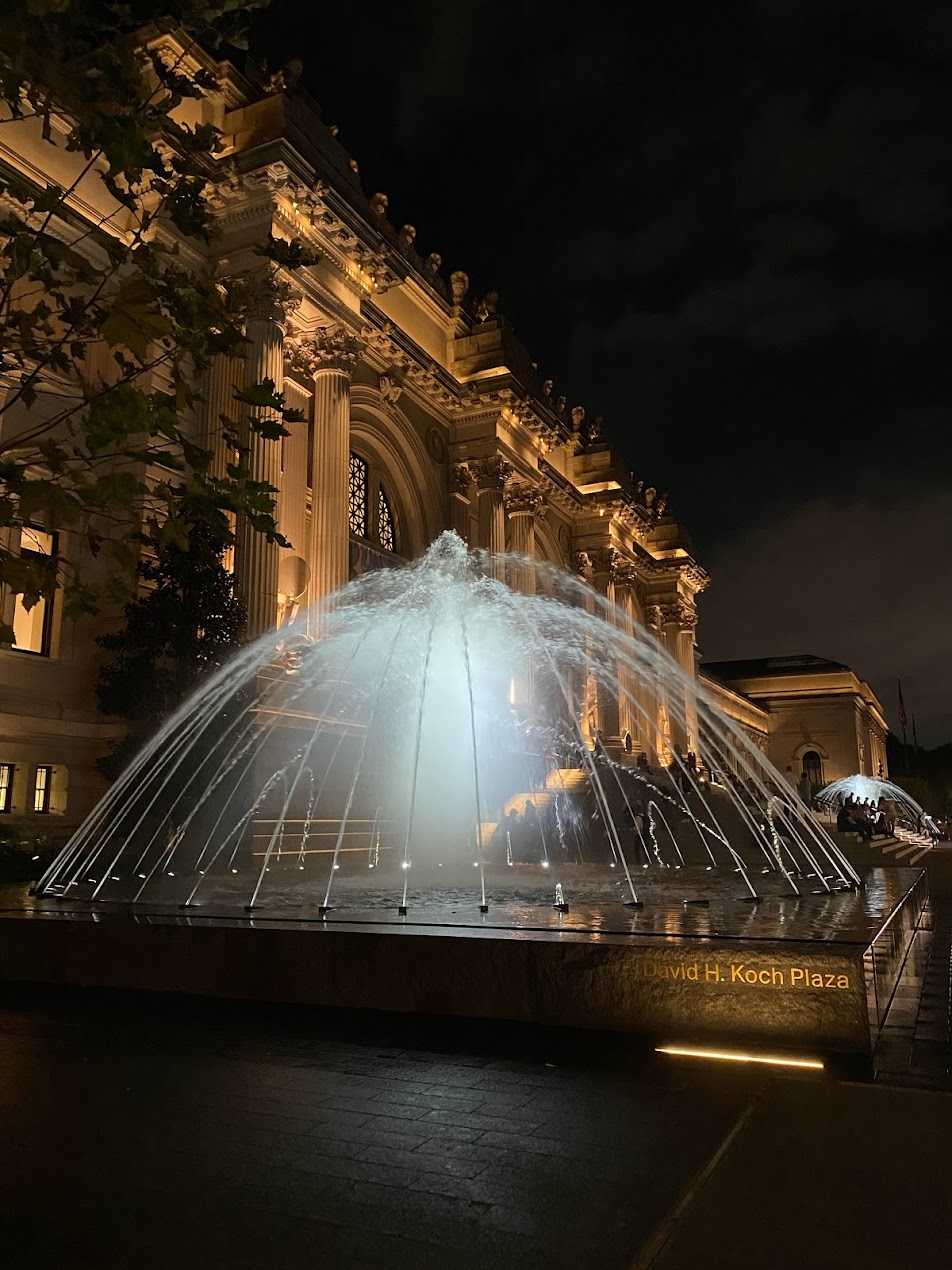 Decades of case law in the U.S. indicate the difficulties facing claimants. Recent cases against New York museums resulted in wins for the institutions, yet not due to the merits of each respective case. Rather, the Museum of Modern Art squeaked out wins through a confidential settlement, and defended itself by claiming that the statute of limitations had run. In another case, the Metropolitan Museum of Art made the affirmative defense of laches, under the theory that claimants made an unreasonable delay in bringing suit against the museum for a valuable painting by Picasso.
Decades of case law in the U.S. indicate the difficulties facing claimants. Recent cases against New York museums resulted in wins for the institutions, yet not due to the merits of each respective case. Rather, the Museum of Modern Art squeaked out wins through a confidential settlement, and defended itself by claiming that the statute of limitations had run. In another case, the Metropolitan Museum of Art made the affirmative defense of laches, under the theory that claimants made an unreasonable delay in bringing suit against the museum for a valuable painting by Picasso.
Even the most recent ruling in the Guelph Treasure litigation did not fare well for the claimant heirs. The Guelph Treasure litigation follows claims brought by the heirs to a priceless haul of German ecclesiastical relics, currently on display in the Bode Museum in Berlin. The heirs claim that the relics were sold under duress to the Nazi government in 1935 for less than their market value. The museum’s foundation argues that the sale was voluntary, and, further, was not made under the pressure of Nazi occupation in Germany.
Last month’s ruling by the District Court for the District of Columbia dismissed the case on jurisdictional grounds, stating that the Foreign Sovereign Immunity Act (FSIA) blocked suit of Germany in U.S. court (this confirms the holding by the U.S. Supreme Court that remanded the matter to the district court). The claimants relied on an exception to the FSIA which prohibits expropriations that violate international law, arguing that dispossession in cases of genocide qualified for this rule. However, the court found that the claimants failed to prove that their ancestors were not German nationals at the time of the sale, meaning that only domestic law – not international law – was involved. As such, U.S. courts do not have subject matter jurisdiction over the matter, meaning that U.S. courts are unable to make determinations on German domestic law.
The district court’s decision does not eliminate the possibility of appeal or further pursuit of the Guelph Treasure through alternate measures in Europe. However, claimants often prefer to file disputes in the U.S. because American courts have historically been more lenient for Holocaust-related actions, particularly on statute of limitations grounds. In most European countries, causes of action for property stolen or lost during WWII have already expired. For example, Poland recently passed legislation that reduced the statute of limitations on all restitution cases to 30 years from the theft’s occurrence; this effectively bars all Holocaust restitution claims.
It is important to note that not all hope is lost. Some museums have, on their own initiative, refused to turn a blind eye to the problematic origins of some of their beloved works. The North Carolina Museum of Art, for example, returned a 16th-century painting by Lucas Cranach the Elder to an Austrian family after learning that the work was stolen by Nazi officials in 1940. And the Museum of Fine Arts in Boston (MFA) recently returned View of Beverwijk by Salomon van Ruysdael to the descendants of a Jewish art collector and politican, from whom the work was stolen by Nazi forces.
In the case of the return of View of Beverwijk, the museum and the claimant family each had a role in making the restitution possible. First, the MFA received new provenance information regarding the work and updated its museum website. The family’s lawyer then used that new information to provide a missing link to prove their ancestor’s possession.
It was truly a moment of teamwork, and sets an example for other museums seeking to actively become part of the solution in remedying the trauma of the Holocaust. The MFA’s curator for provenance, Victoria Reed, stated (upon the return), “To be able to redress that loss, even in a tiny way, I think, is gratifying. And it certainly is part of what we should be doing as a museum.”
At the same time, voluntary returns of artwork by museums are few and far between, and the battle for individuals seeking to prove provenance remains a lengthy, cumbersome, expensive, and uphill battle. In light of these hurdles, requiring museums to publicly notify guests of the potentially tragic origins of works they have on display is a start. Doing so gives voice to the people who were silenced under the traumatic and systematic genocide of the Holocaust and lost their homes, families, and ties to their history and culture.
New York’s actions, in this sense, are an act of strength in the face of the general reluctance by museums to acknowledge that there are times in which the display of art may perpetuate war crimes. As Maya Angelou put it, “History, despite its wrenching pain, cannot be unlived. But if faced with courage, need not be lived again.”
by Amineddoleh & Associates LLC | Jul 27, 2022 |
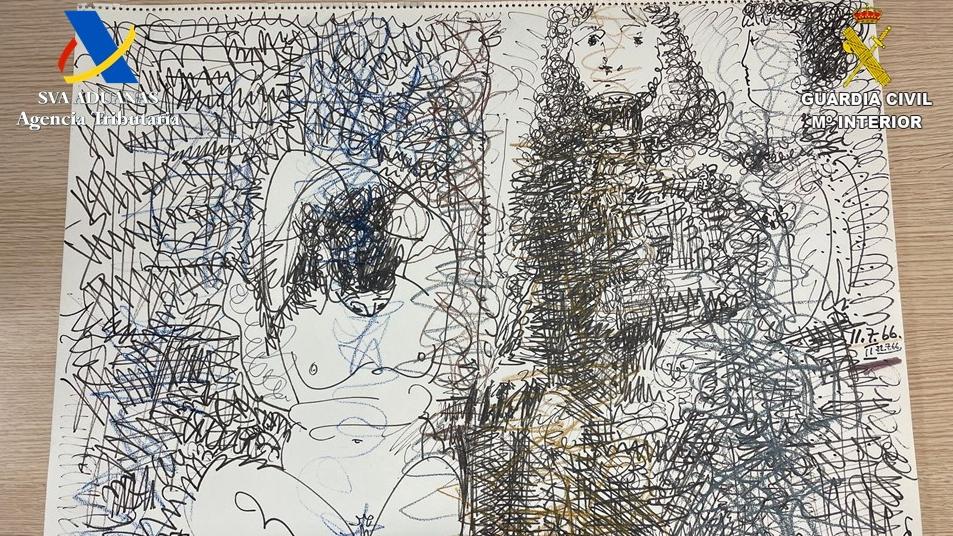 Last week, customs officials on the Spanish island of Ibiza discovered something a bit more exciting than the usual partygoers and tourists – a sketch by Pablo Picasso worth over $463,000. The sketch (Trois Personnages, 1966) was flown into Ibiza from Switzerland. It was found in a passenger’s suitcase after he failed to declare the contraband artwork. He attempted to pass off the original artwork as a print by presenting a falsified receipt listing its value as $1,550. Swiss customs officials noted that the work had been packed in a suspicious manner and alerted their Spanish counterparts. Once the plane arrived in Ibiza, customs officials approached the passenger. After being presented with the false receipt, the agents located another receipt at the bottom of the luggage revealing the supposed print’s true value. The sketch was quickly sent to an art expert, who confirmed its authenticity. The passenger now faces criminal charges of smuggling, failing to declare the value of the artwork, and presenting authorities with a false receipt. The sketch is in the custody of the Ibiza court overseeing the investigation.
Last week, customs officials on the Spanish island of Ibiza discovered something a bit more exciting than the usual partygoers and tourists – a sketch by Pablo Picasso worth over $463,000. The sketch (Trois Personnages, 1966) was flown into Ibiza from Switzerland. It was found in a passenger’s suitcase after he failed to declare the contraband artwork. He attempted to pass off the original artwork as a print by presenting a falsified receipt listing its value as $1,550. Swiss customs officials noted that the work had been packed in a suspicious manner and alerted their Spanish counterparts. Once the plane arrived in Ibiza, customs officials approached the passenger. After being presented with the false receipt, the agents located another receipt at the bottom of the luggage revealing the supposed print’s true value. The sketch was quickly sent to an art expert, who confirmed its authenticity. The passenger now faces criminal charges of smuggling, failing to declare the value of the artwork, and presenting authorities with a false receipt. The sketch is in the custody of the Ibiza court overseeing the investigation.
Yet this is not the first incident involving a smuggled Picasso in Spain. Jaime Botín, former chairman of Spanish bank Bankinter, was sentenced to 18 months in jail and received a $58 million fine (increased to $101 million) in 2020 after attempting to smuggle a painting by Picasso (Head of a Young Woman) out of the country aboard his private yacht. Botín had originally purchased the painting, worth $29 million, in London in 1977. He later planned to sell it at auction, but was unable to remove it from Spain. Christie’s London applied to the Spanish Ministry of Culture for an export permit in 2013 (on Botín’s behalf) but it was denied. The Ministry found that the artwork qualified as a national treasure since it was over 100 years old and the Ministry deemed it culturally significant. The painting is notable for being one of the few exemplars of Picasso’s Rose Period and presents various similarities with the figures in Les Demoiselles d’Avignon, one of the artist’s seminal works and a highlight of the Cubism movement. An art expert deemed the work unique and stated that it is highly unlikely that another painting with these characteristics exists in Spain – or Europe.
Botín was undeterred by the government’s pronouncement as he brazenly took it aboard his yacht, where he sailed to Corsica in 2015. French customs officials boarded the vessel and seized the painting at that time. It was suspected that Botín planned to take the work to Switzerland and sell it there. Botín claims that he was transferring the work abroad for safekeeping, and that he could do so as the legitimate owner of the painting. However, Spain’s patrimony law clearly prohibits the removal of national treasures from Spanish territory without the approval of the Ministry of Culture. The court’s imposition of a substantial fine is indicative of the seriousness with which Spain views attempts to circumvent its cultural heritage export ban; this is the first time a sentence of this magnitude has been imposed in a case involving artwork.
Head of a Young Woman is currently on view at the Reina Sofía Museum in Madrid, where it was transferred for safekeeping in 2015 after its seizure. It will feature in an upcoming exhibition to mark the 50th anniversary of Picasso’s death in 2023. Meanwhile, a court exempted Botín from serving his jail sentence due to illness and advanced age (85), although he ultimately paid the increased fine. He continues to maintain his innocence and stated that he hopes to display the painting at his family’s Centro Botín in Santander one day.
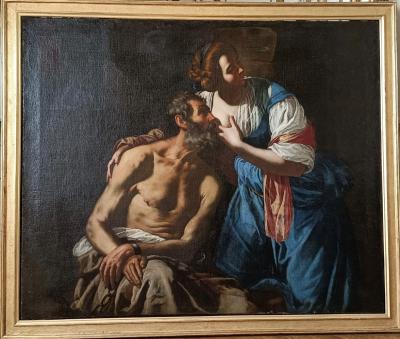 The problem with smuggled works is not unique to Spain. Just last week, it was reported that a 17th century painting by Artemisia Gentileschi was recovered after it was illegally exported from Italy. The work was recovered and repatriated from Austria to Bari. Two people are being investigated for fraud and illegal export of cultural goods. They disguised the attribution and concealed the historical importance of the work in order to obtain permission to export the painting out of Italy.
The problem with smuggled works is not unique to Spain. Just last week, it was reported that a 17th century painting by Artemisia Gentileschi was recovered after it was illegally exported from Italy. The work was recovered and repatriated from Austria to Bari. Two people are being investigated for fraud and illegal export of cultural goods. They disguised the attribution and concealed the historical importance of the work in order to obtain permission to export the painting out of Italy.
by Amineddoleh & Associates LLC | May 13, 2020 |
ART THEFTS: PART II
Inside Jobs and Insider Knowledge
Many art thefts are indeed crimes of opportunity, including instances of inside jobs. Objects sometimes disappear from storage and then reappear on the market months, or even years, later. Some employees take advantage of internal museum procedures, such as removing a work for photography or cleaning, to waylay an artwork and use it for their own ends. As recounted in Part V of this series, one of the most notorious inside thefts known to the public concerns none other than the Mona Lisa, the most valuable and recognized painting in the world.

Copyright Guggenheim Foundation
In 1990, the Solomon R. Guggenheim Museum in New York sued Jules Lubell for the return of a Marc Chagall painting that had been purchased by the collector and her husband in 1967 and worth approximately $200,000. The Lubells had purchased Menageries from a reputable dealer, the Robert Elkon Gallery. The invoice and receipt stated that the artwork had been “formerly in the collection of George A. Frankiel, Paris.” As it was later revealed, Mr. Frankiel did not have a Parisian collection, rather he was a mailroom employee at the Manhattan museum. The painting’s provenance stated that Mr. Frankiel had sold the painting to another Manhattan art dealer, Gertrude Stein, before Mr. Elkon had sold it to the Lubells.
The museum had initially been unaware that the work was stolen. Once the institution discovered its disappearance, it formally deaccessioned the painting from its collection after a comprehensive inventory. However, the museum failed to take any actions to recover the work, such as publicizing the theft, hiring of a private investigator, filing of an insurance claim, or initiating a search beyond its premises. The museum justified its lack of action due to its belief that it would hinder the work’s recovery and potentially drive it deeper underground on the black market. The museum only became aware of the its location in 1985 when a dealer, acting on behalf of Mrs. Lubell, presented an image of the work to Sotheby’s for an auction estimate. A former Guggenheim employee, the Sotheby’s specialist recognized the work and notified the Guggenheim about its missing property. The museum demanded that Mrs. Lubell return the Chagall work to the museum, but she refused. In September 1987, the Guggenheim filed a lawsuit. The parties spent years litigating over procedural issues, such as the defenses of statute of limitations and laches. Ultimately, the parties settled out of court in December 1993, one day after the trial had already begun. Although the terms of the agreement are confidential, it is believed that Mrs. Lubell and the art dealers paid the museum the fair market value of the work to compensate it for the loss.

Policemen leave the Residenzschloss Royal Palace that houses the historic Green Vault (Gruenes Gewoelbe) in Dresden, November 27, 2019. (Photo by Robert Michael / dpa / AFP) / Germany OUT (Photo by ROBERT MICHAEL/dpa/AFP via Getty Images)
One of last year’s biggest thefts was likely also committed by individuals with an inside connection to a museum. Dresden’s Green Vault suffered a terrible loss in November when burglars stole eleven irreplaceable and culturally significant pieces of Baroque jewelry from the collection. Criminals sprayed fire extinguishers to cover their tracks after starting a fire at an electrical box that plunged the museum into darkness and deactivated the alarm system. That allowed them to break through the museum’s iron gate and shatter a small window to gain access to the historic Green Vault. Thereafter, they axed the glass vitrines that displayed some of the museum’s exceptional items. Founded by Augustus the Strong (we featured his Persian carpets in another post), an 18th-century prince-elector of Saxony and King of Poland, the Green Vault has one of the greatest collections of Baroque treasures. The stolen objects are estimated to be worth about $1 billion. Sadly, some of the precious jewels have popped up for sale on the dark web, offered for millions of dollars apiece. As the investigation progresses, it appears that the theft was an inside job, with some of the security guards currently under investigation.
In 2014, an anonymous source informed the Turkish cultural minister about an organized crime syndicate that used an insider to steal works from the State Art and Sculpture Museum in Ankara, Turkey. According to an anonymous source, the gang earned a whopping $250 million from their thefts. They purportedly stole artworks and antiquities from the museum between 2005 and 2009, some of which were replaced by fakes or other objects of dubious authenticity. In other cases, the items were simply removed from the museum’s storage facilities. Notably, the museum had received criticism for its inadequate inventory system prior to the crimes. That same year, it was announced that another museum had difficulties with inventorying of its collection because hundreds of artworks were missing from El Museo del Prado in Madrid. Spain’s Tribunal de Cuentas (the Court of Auditors) investigated the matter and determined that the losses were not recent but had occurred over the course of decades. Although some losses were the result of fire or war, other losses went unnoticed due to a subpar tracking and inventory system. Unfortunately, many institutions around the world do not adequately inventory and track their holdings.
Thefts from Private Collections
Works are also frequently stolen from private collections. For instance, the law firm of Borghese Associés SELARL handled a case involving Picasso’s heirs and their electrician uncovered the theft of hundreds of the artist’s artworks during proceedings that took over a decade to complete.
In 2009, Pierre Le Guennec, the electrician who had installed a security system in Pablo Picasso’s villa Notre Dame de Vie in Mougins during 1971, revealed that he had 271 undocumented artworks in his possession. Mr. Le Guennec claimed the artist gifted to him the works as a token of appreciation. These artworks have not been signed or inventoried at the time of the painter’s death in 1973. The pieces resurfaced years later when Mr. Le Guennec requested Claude Ruiz-Picasso, the artist’s son, to authenticate 180 watercolor paintings, lithographs and Cubist collages, as well as two notebooks with 91 drawings (circa 1900-1932). Together these pieces form a heterogeneous collection of Picasso’s art.
Suspecting that the artworks were stolen, the Picasso heirs filed a complaint with the French court. At first, the electrician claimed that Pablo Picasso gifted the artworks to him on or around 1971 or1972 as a “thank you” for his devoted work for the artist during the early 1970s. However, on appeal, Mr. Le Guennec completely changed his story claiming that the artist’s widow Jacqueline donated the object to him. The case proceeded all the way to the Court of Cassation (France’s highest court) that ultimately overturned the decision of the appellate court, and ruled in favor of the heirs. The Court of Cassation remanded the case to the Lyon Court of Appeals, and in 2019, it finally convicted the electrician and his wife for receiving the 271 artworks. In fact, the court’s 41-page decision determined that the statements of the convicted parties are fraudulent and the provenance of the artworks was flawed beyond a reasonable doubt.
Antiquities Looting
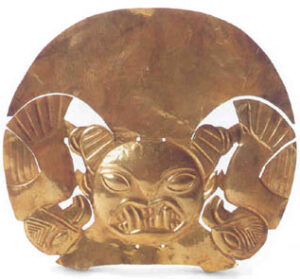
Moche Headdress, Marco Museum Collection
The looting of antiquities is often a crime of opportunity. The very nature of unexcavated objects is that their existence is likely unknown. For undiscovered antiquities, they may not have been seen for millennia. In essence, these objects do not have a modern ownership history (provenance); therefore, it is difficult or sometimes impossible to trace them back to their place of origin.
Antiquities looters around the world are generally motivated by money. Yet not all looters earn substantial financial profits, but rather plunder sites to feed their families. The problem is of a global scale, as poverty in developing nations creates incentives for struggling populations to plunder and sell artifacts to illicit traffickers at low prices. Pillaging also occurs in impoverished regions of developed nations, such as Italy, China, Greece and Cyprus. At the same time, these nations or regions often lack resources to protect archaeological sites, creating an opportunity for the looters. As Jan Pronk noted in a speech given at the Rijsmuseum voor Volkenkunde in Leiden, “After all, if you were poor and someone offered you a year’s salary for every object you found, would you not pick up a spade and start digging?”
Peru serves as an excellent example as it has suffered the extensive loss of its heritage through rampant looting, often done by locals supplying artifacts on the international market. The site of Sipán in Peru dates to approximately 700 BC and is assigned to the Moche Culture. By the mid-1980s, that area had been minimally recorded by archaeologists and government surveyors, and it had not been archaeologically excavated. The famed archaeological treasures from Sipán come from a large man-made mound called Huaca Rajada. Beginning in November 1986, a group of raiders tunneled into Huaca Rajada, and after a few months, the group came upon a few golden objects. Just like in a movie, after cutting a hole into the roof of the tunnel, treasures cascaded down onto the group. The thieves filled sacks with riches but were unable to determine how to split profits from the sale. As a result, one of the looters informed the local authorities about the operation, and it was stopped by police. Sadly, items from Sipán continue appearing on the international market.
Looting During Conflict
Our founder, Leila A. Amineddoleh, served as the cultural heritage law expert for the Manhattan District Attorney’s Office in a matter concerning looted property from Lebanon. In late 2016, the director of the Metropolitan Museum of Art notified Lebanese authorities that a marble bull’s head, on loan to the museum, appeared to have come from the archaeological site of Sidon. In January 2017, the Lebanese Director General of Antiquities demanded its return.
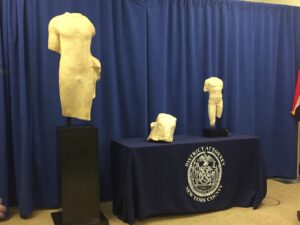
Repatriation ceremony in Manhattan
The bull’s head was excavated near Sidon from the Temple of Eshmun, dedicated to the Phoenician god of healing. The site was occupied from the 7th century BC to the 8th century AD. Rediscovered in 1900, famed French archaeologist Maurice Dunand excavated the site from 1963 until the start of the Lebanese Civil War in 1975. During a state-sponsored excavation, Dunand discovered the Bull’s Head in 1967. The marble was from the capital of a pillar from the Temple of Eshmun, and it was carved between the 6th and 4th centuries BC, when Lebanon’s Phoenician civilization was ruled by Persia, and its art was influenced by Greek and Persian but also influenced by Greek sources. The head’s discovery was well-documented in the official records and academic sources of the state. Documentation also reports that during the nation’s civil war, the sculpture was moved in 1979 to Beirut to be placed into a secure storage area of the Byblos Citadel for safekeeping. Sadly, the citadel was breached in 1981, and the Bull’s Head was stolen.
The marble went missing for over three and a half decades and then appeared at the Met on loan from collector Michael Steinhardt who had purchased it from other collectors, William and Lynda Beierwaltes. Once Mr. Steinhardt was informed of the work’s problematic provenance, he demanded a refund for the purchase and transferred the title to the object back to the sellers. The movement of the piece from 1981 through 2017 was reconstructed through shipping forms and sales receipts, including documents from dealers known to trade in problematic antiquities. The collectors and dealers involved all claimed they had the right to buy and sell the sculpture. Importantly though, missing from that paperwork was the necessary permission from Lebanon to remove the marble from its borders or sell it. Ultimately, the Bull’s Head was repatriated to Lebanon, in part due to the records and the lack of verifiable legitimate provenance. Sadly, more than 500 Eshmun statues were looted from the Byblos Citadel, and only a handful have been returned to Lebanon. Additional details about the journey of the Bull’s Head can be found here.
Cambodia experienced a brutal period of conflicts and civil wars in the 1960s and 1970s, during which time the archaeological site of Koh Ker fell victim to extensive looting. The dispute over a 10th century sandstone statue of epic warrior Duryodhana began in 2011 when the Kingdom of Cambodia initiated legal action against Sotheby’s. The auction house was selling a 10th century sculpture, that was purportedly looted in or around 1972 from Koh Ker. In fact, experts could pinpoint the exact place from where the statue originated because the base and feet remain in situ.
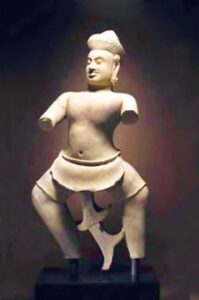
Photo courtesy of Phnom Penh Post
After being violently removed from its base, the Khmer statue entered the black market and was sold to a Belgian collector in 1975. The collector’s wife consigned the statue for sale at an auction in 2010 and imported it into the U.S. An auction house researcher expressed concerns about the object, stating in an email that she believed it was stolen. That expert later changed her opinion about the sale and advised Sotheby’s that Cambodia generally doesn’t request the return of looted art. On the day of the auction, Cambodian officials demanded that Sotheby’s withdraw the lot and return the statue. Sotheby’s withdrew the item but supported the collector’s ownership claims. The U.S. Department of Homeland Security opened an investigation, and the U.S. filed for a forfeiture. In December 2013, the U.S. government and Sotheby’s ultimately signed a settlement agreement and Sotheby’s returned the statue to Cambodia. Due to that case, the Cambodian government began investigating a number of works taken from the same site. Consequently, a number of similar statues were returned. Around the time of the Sotheby’s return, the Norton Simon Museum repatriated its own looted Cambodian statute to its home. Rather than litigate, the museum offered to return the statue as a “gift.”
Protection of art and cultural objects during the uncertain times of COVID-19
World War II led to a vast displacement of art, conflict in the Middle East resulted in wide-scale looting, and poverty in many “source” nations has been the driving force behind the illicit plunder. The global COVID-19 pandemic’s effect on the cultural institutions and private collections is still uncertain; however, players within the market must prepare for various ramifications of this disaster.
Cultural institutions and museums of all types and origins face similar challenges, such as maintaining high levels of security and preservation of the collections, providing their staff with a healthy and safe work environment, soliciting financial endowments, and digitally engaging with their audiences in a meaningful way. The COVID-19 pandemic has already made it difficult for museums to generate the revenue necessary for covering operational costs and adequately staffing their properties. These shortcomings during a worldwide crisis make institutions vulnerable to theft and may lead to the deterioration of art collections. Economic losses aside, security personnel and conservation specialists of some museums feel that their safety is being compromised while at work, and so they choose not to show up at all. For instance, at the onset of the pandemic in early March, the employees of the Louvre Museum in Paris refused to work, citing COVID-19 health and safety concerns. As a result of the protest, on April 16, the International Council of Museums published a series of recommendations for the conservation of museum collections. The publication urges essential staff, including security guards, to stay on the premises of the institutions in order to “to fulfill their primary function of conserving the material and immaterial heritage of humanity.”
As the pandemic has had an undeniable impact on the finances of art-related businesses, various governmental bodies and private foundations across the world are offering financial relief to those entities and individuals. For instance, the French Ministry of Culture allocated 2 million euros in emergency funding to art galleries, labeled art centers and artists-authors. This funding will be operated by the National Centre for Plastic Arts (“CNAP”) and the regional directorates for cultural affairs (“DRAC”). These resources aim to reduce the adverse impact of the pandemic on the cultural institutions and businesses worldwide.
Only time will tell how the COVID-19 pandemic will change the art market and alter the life of museums. But history suggests that it is essential for museums and collectors to take precautionary measures to safeguard their valuable artistic and cultural holdings.

 Of course, this is devastating news to families seeking to reclaim an important piece of family heritage. If a museum denies heirs’ claims, they may proceed to file litigation. One high-profile example is Gustav Klimt’s portrait of Maria Altmann, titled
Of course, this is devastating news to families seeking to reclaim an important piece of family heritage. If a museum denies heirs’ claims, they may proceed to file litigation. One high-profile example is Gustav Klimt’s portrait of Maria Altmann, titled  Decades of case law in the U.S. indicate the difficulties facing claimants. Recent cases against New York museums resulted in wins for the institutions, yet not due to the merits of each respective case. Rather, the Museum of Modern Art squeaked out wins through a confidential
Decades of case law in the U.S. indicate the difficulties facing claimants. Recent cases against New York museums resulted in wins for the institutions, yet not due to the merits of each respective case. Rather, the Museum of Modern Art squeaked out wins through a confidential  Last week, customs officials on the Spanish island of Ibiza discovered something a bit more exciting than the usual partygoers and tourists – a
Last week, customs officials on the Spanish island of Ibiza discovered something a bit more exciting than the usual partygoers and tourists – a  The problem with smuggled works is not unique to Spain. Just last week, it was reported that a 17th century painting by
The problem with smuggled works is not unique to Spain. Just last week, it was reported that a 17th century painting by 



